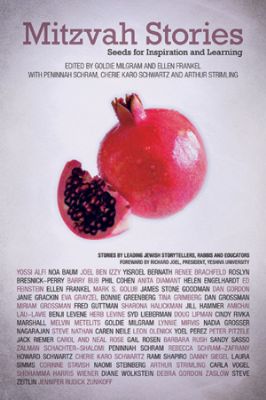
by Rabbi Amichai Lau Lavie
From Mitzvah Stories: Seeds for Inspiration and Learning
The dress, blue and billowing, appeared out of nowhere and vanished right back. Maybe it never really existed? The facts don’t matter much. This is a different kind of knowing. The dress, a perfect fit, taught me the most unusual and subtle of Jewish commandments: Know yourself by transforming yourself: turn reality upside down, silly and sacred, for just one day a year. A mask of sorts, the dress transformed me into another, teaching me how to be my very self by being, briefly, not myself at all.
“On the holiday of Purim,” instructs the Talmud, “one must be sufficiently intoxicated so as not to know the difference between the evil Haman and the righteous Mordechai” [BT Megillah 7b].
As far as the rigid system of Jewish laws goes, this is a wild card, obligating the pious to step beyond the safe and ordinary codes of conduct, endorsing chaos and the blurring of boundaries. The commandment originates in the Biblical scroll of Esther, echoing the moment in which the tables are turned and the Jewish would-be-victims seize control: “ve’nahpoch hu”—upside down, topsy-turvy, and transgression as a state of mind. Purim commemorates this mythic moment with an obligatory annual day of celebration, complete with drinking beyond capacity and dressing up. It’s a complicated commandment, rarely fully obeyed.
It was always my favorite. From an early age—as young as five years old—I’d wait for Purim. As soon as Yom ha-Kippurim was over, I’d start planning my costumes. The masks and make-believe, the fabrics of fabrication, this carnival of imagination, gave me permission to play, to pretend, to paint outside the rigid lines of religious regulations.
Only many years later I would learn how deeply connected Purim and Yom ha-Kippurim are—each offering the human soul another attempt at change and transformation. But as a child I cared only for the shiny fabrications of self: a medieval troubadour in green velvet, Dr. Doolittle with stuffed animals pinned to my hat, a British Palace Guard, an astronaut. But mostly, and most often, I’d dress as a girl: my cousin Rachel, Mary Poppins, an old Russian babushka, a bride. There was that time I dressed as a princess, and went with mother and a basket of chocolate-covered strawberries to visit Tante Jenny in her nursing home nearby. She held court in her immaculate tiny lounge, barely seeing, wrapped in a floor-length evening gown, silvery and shining, from those days in Berlin, wrapped in a fur, dripping with diamonds. Her fragile friends, in jewels and ball gowns, sat around her, sipping cognac from crystal goblets, laughing a lot and loving my costume. That was her last Purim. And that was the last time I was permitted to wear a dress on Purim.
“You are a big boy now,” mother explained as she drove us back home. I was nine. “Enough is enough.”
There is another commandment, a religious law, prohibiting cross-dressing. It is perfectly clear: “A woman must not wear the garments of a man, nor may men wear the dress of a woman—these are abominations” [Deuteronomy 22:5].
But somehow, sometimes, the forbidden blurs, as commandments collide, crossing over the invisible boundaries of proscribed and prohibited, familiar and feared. And there, and then, in that no man’s land of legal obscurity, the threshold of Purim, is when the dress appeared, twice in a lifetime, shaking things up.
It was blue, crisp cotton, with white polka dots, puffy short sleeves, and a full skirt, and it showed up in the costume box, just like that, on the day before Purim, a few months after Tante Jenny died. The costume box was a large trunk, stationed along the wall in our backyard, next to the plum tree. Lace curtains became veils inside that box, and ragged rags turned to magic cloaks. On Saturday mornings, after we came back from synagogue, the box would open and we would play: bull fights with Gypsy the dog, weddings under the grand piano.
I hadn’t seen this dress before but somehow knew it once belonged to my mother. I vaguely remembered a black and white photograph of her as a very young woman, smiling, radiant, lit by a Mediterranean sun, a dark dress with white dots tight on her body.
Slippers appeared, too: Black, pointy, with low heels, open at the back. I slipped them on, and wore the dress, and trotted out into the street, one hand pinching the hem of the dress, the other clutching the black velvet skullcap, which I had taken off. It was mid-afternoon, and the streets were quiet and empty as I made my way, heels clicking on the pavement, off to meet my friends at a pre-Purim party. The walk was long, and I remember the heat and the quiet, an occasional glance from a passing driver slowing down, a figure in a window pulling curtains aside to get a better look. I remember the shame, and the sinking feeling in my stomach that something was terribly wrong and that nothing was the same as it used to be or would be again.
And then, twenty years later, she returned.
It was the morning before Purim. I opened my closet, at home in downtown New York City, to get dressed for work. An unfamiliar shape and color caught my eye. A dress, blue, billowing, with white polka dots, was hanging, simply, among my suits.
I didn’t question its existence or origin. It smelled faintly of familiar perfume. And it fit just right. That night I wore it to the synagogue, dressing up for the first time in all those years. There may have been shoes, too, or make-up, perhaps a wig. The scroll of Esther was chanted; the music started. I danced, carefully at first. We were laughing a lot, and sipping cognac from flasks and, later, crystal goblets. Free to be someone else, I was more myself than ever before. The dress was just a garment, but I wore it on the inside, too.
I wore it the next day too, visiting friends for Purim feasts, giggling, giddy, delivering little baskets of chocolate-covered strawberries, Hershey kisses, bottles of wine. She slowly emerged—a wise widow, teaching and preaching deep secrets I did not know I knew—yet all who listened loved and wanted more. Purim was back—a carnival of colors, a masquerade of myth and magic, permission to ponder and penetrate secrets, to peel off a mask and wear another, or perhaps, none at all. At some point I walked up a staircase, hearing the click-clack of high heels on marble, the familiar sound of my mother, aunts, grandmother, coming up to tuck me in and say goodnight. The heels were mine, but whose were the memories? I paused on the staircase, breathless with the knowledge that I was them, all of them, understood them for the first time, and knew who I was and why I loved them, and loved myself, just as I was, perhaps, again, for the very first time.
And then, at dusk, I took the dress off in the bathroom, hanging it up before changing back into the ordinary. It was left alone in the bathroom for just a moment when the fire began. Was it the candle that caught on cotton? Was there a candle at all? When I ran back, in stockings, smoke filled the bathroom and soon the apartment, and the alarm was wailing and the dress was gone.
No photographs were taken that day, and no tears spilled. But the singed smell lingered in the bathroom, like mystery, like loss. Fact or fiction? Was there really a dress at all? Ad lo yada—the commandment of Purim is to not know at all, and none of this is about real knowledge, hard facts. It doesn’t really matter. Purim has never been the same again, nor have I. She wrapped me tightly, blue and perfect, reminding me to live and learn and laugh and love and care for the most complex of all commandments, Jewish, human, timeless: know yourself to know the other—become yourself, with all true colors of compassion, polka dots, permission, tears and fears and courage: at least one day a year.
 BUY NOW:
BUY NOW:
Mitzvah Stories: Seeds for Inspiration and Learning
Paperback and Kindle also available
STORY AUTHOR BIO: Amichai Lau Lavie, founding director of STorahtelling, Inc and Lab Shul in lower Manhattan, NY. He is an Israeli-born teacher of Judaic Literature. He is a rabbinical student at JTS and has studied at Har Etzion, the Shalom Hartman Institute and the Elul Center in Jerusalem. He has written and/or performed with the Theatre Company Jerusalem, The Acco Theatre Group and the Avodah Dance Ensemble. Amichai has served as Artist-in-Residence at Congregation B’nai Jeshurun and as a Jerusalem Fellow at the Mandel Leadership Institute, as consultant to the Reboot Network, and as a member of the Synagogue 3000 Leadership Network, the Advisory Council for the Six Points Fellowship, the Advisory Board for Faithhouse Manhattan, and the Board of Directors of Nehirim.